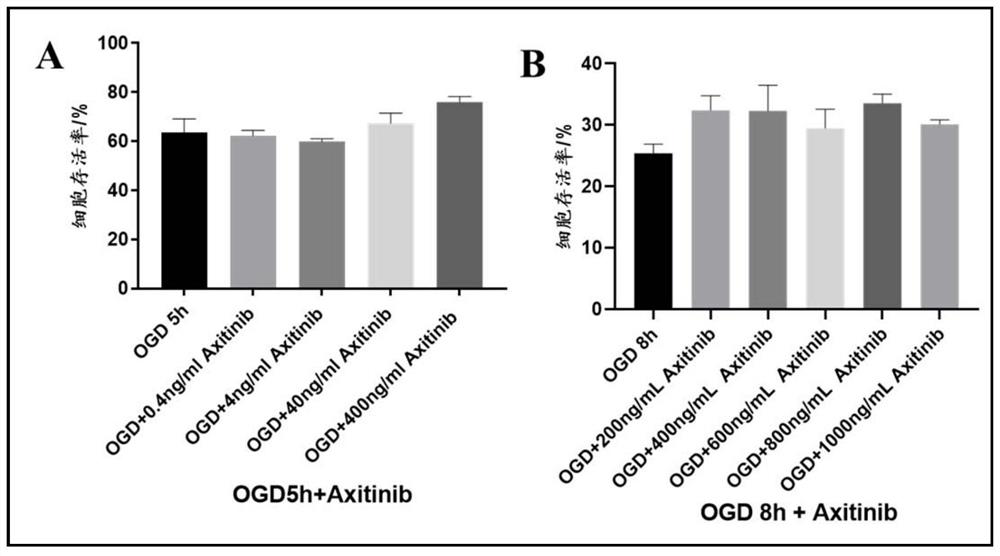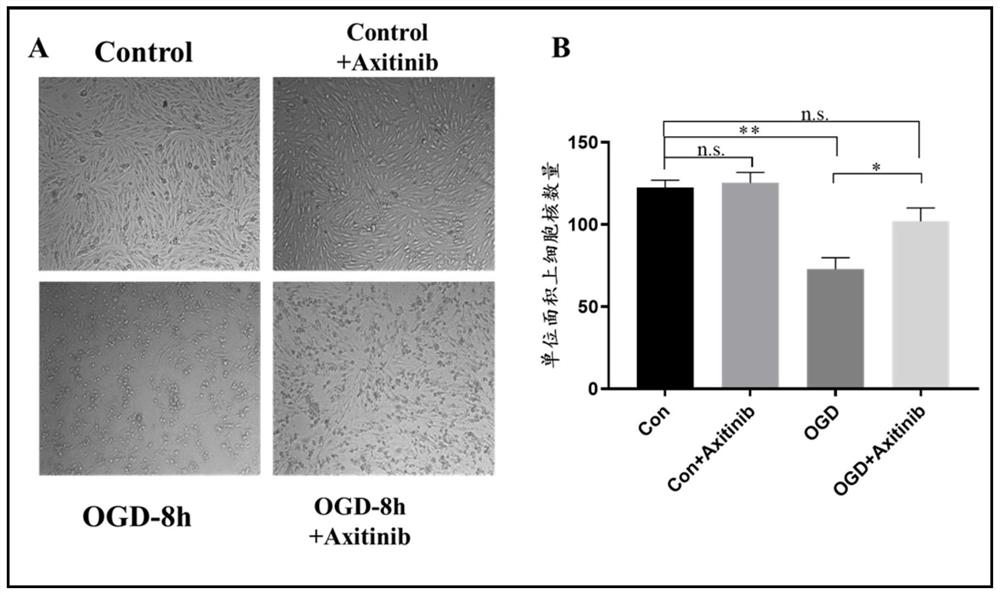Application of axitinib and analogue in preparing anti-ischemic cerebral stroke medicine
A technology of axitinib and analogs, which is applied in the application field of axitinib and analogs in the preparation of anti-ischemic stroke drugs, can solve the problems of slow onset, limited therapeutic value, etc., and achieves safety High efficacy, convenient administration, and high application value
- Summary
- Abstract
- Description
- Claims
- Application Information
AI Technical Summary
Problems solved by technology
Method used
Image
Examples
Embodiment 1
[0031] Example 1 Axitinib Reverses the Apoptosis of Cerebral Microvascular Endothelial Cells under Oxygen and Glucose Deprivation Conditions
[0032] 1.1 Oxygen-glucose deprivation-induced vascular endothelial cell injury and drug regulation Taking mouse brain microvascular endothelial cells bEnd3 as the research object, using oxygen glucose deprivation (Oxygen Glucose Deprivation, OGD) to induce vascular endothelial cell injury as an in vitro model, simulating ischemic cerebral microvascular injury, and investigating the relevant indicators of vascular endothelial cells before and after ischemic injury expression changes. The specific method is as follows: when the cells were completely confluent, they were washed 3 times with sugar-free medium HBSS (Hank’s balance salt solution, HBSS) preheated to 37°C, and replaced with an appropriate volume of sugar-free medium for culture. That is, the cells were placed in a hypoxic airtight box, and anaerobic mixed gas (95% N 2 and 5%...
Embodiment 2
[0043] Example 2 Axitinib inhibits down-regulation of tight junction proteins in brain microvascular endothelial cells under oxygen-glucose deprivation conditions
[0044] The oxygen-glucose deprivation injury constructed by the method described in 1.1 of Example 1 was used as a model. The barrier function of the blood-brain barrier is mainly controlled by tight junction proteins Claudin-5 and Occludin on brain microvascular cells. Therefore, this patent mainly investigates the protective effect of axitinib administration on the tight junction protein damage of bEnd.3 cells induced by OGD.
[0045] 2.1 Western blot method to detect the expression of tight junction protein Claudin-5 in each treatment group
[0046] bEnd.3 cells at 2×10 5 The density per well was seeded on a 6-well plate. After 7 days of culture, axitinib was added at a dose of 400 ng / mL (dissolved in 2 μL of DMSO). Both the OGD group and the treatment group were treated with OGD for 8 hours, and the contro...
Embodiment 3
[0051] Example 3 Administration of axitinib restores blood-brain barrier function in rats with acute ischemic stroke
[0052] 3.1 Construction of animal model of middle cerebral artery occlusion and reperfusion in rats
[0053] Referring to the rat middle cerebral artery occlusion model and reperfusion (MCAO / R) model established based on the literature, the rat unilateral middle cerebral artery embolism model was prepared by suture method, resulting in focal ischemic cerebral infarction. stroke. Specifically, male adult Wistar rats with a body weight of 270-290 g were selected. 10% chloral hydrate 0.33ml / 100g intraperitoneal injection of anesthetized rats, the rats were fixed in the supine position, the skin was incised in the middle of the neck, each layer of tissue was bluntly separated, the right common carotid artery was exposed, and the external carotid artery and Internal carotid artery. Tie a slipknot at the proximal end of the common carotid artery. The common ca...
PUM
 Login to View More
Login to View More Abstract
Description
Claims
Application Information
 Login to View More
Login to View More - R&D
- Intellectual Property
- Life Sciences
- Materials
- Tech Scout
- Unparalleled Data Quality
- Higher Quality Content
- 60% Fewer Hallucinations
Browse by: Latest US Patents, China's latest patents, Technical Efficacy Thesaurus, Application Domain, Technology Topic, Popular Technical Reports.
© 2025 PatSnap. All rights reserved.Legal|Privacy policy|Modern Slavery Act Transparency Statement|Sitemap|About US| Contact US: help@patsnap.com



